Effects of Grain Boundary Misorientation Angle on the Mechanical Behavior of Al Bicrystals
Abstract
:1. Introduction
2. Materials and Methods
2.1. Molecular Dynamics Modeling
2.2. Simulations and Specimens
3. Results and Discussion
3.1. Deformation Mechanisms and Mechanical Properties
3.2. Fracture Resistance
3.3. Crack Propagation under Cyclic Loading
4. Conclusions
- GB misorientation has a beneficial effect on the mechanical properties of Al bicrystals, increasing the with increasing misorientation angles.
- Regarding fracture resistance, the GB misorientation improves and with increasing misorientation angles.
- A gradual change from brittle (for 0° °) to ductile (for > 20°) behavior is observed in Al bicrystals for tilt GB misorientations.
- For twist GB misorientations, abundant voids and dislocations are formed in the bicrystals, suggesting a ductile behavior.
- GB misorientation works as a barrier that arrests crack growth, as observed in the simulations of cracked bicrystals.
Author Contributions
Funding
Data Availability Statement
Conflicts of Interest
References
- Berman, D.; Krim, J. Surface science, MEMS and NEMS: Progress and opportunities for surface science research performed on, or by, microdevices. Prog. Surf. Sci. 2013, 88, 171–211. [Google Scholar] [CrossRef]
- Li, X.; Bhushan, B. Fatigue studies of nanoscale structures for MEMS/NEMS applications using nanoindentation technique. Surf. Coatings Technol. 2003, 163–164, 521–526. [Google Scholar] [CrossRef]
- Wang, B.; An, X.; Xue, P.; Liu, F.; Ni, D.; Xiao, B.; Liu, Y.; Ma, Z. Grain size effects on high cycle fatigue behaviors of pure aluminum. Int. J. Fatigue 2023, 170, 107556. [Google Scholar] [CrossRef]
- Nellessen, J.; Sandlöbes, S.; Raabe, D. Low cycle fatigue in aluminum single and bi-crystals: On the influence of crystal orientation. Mater. Sci. Eng. A 2016, 668, 166–179. [Google Scholar] [CrossRef]
- Xie, G.; Wang, F.; Lai, X.; Xu, Z.; Zeng, X. Atomistic study on crystal orientation-dependent crack propagation and resultant microstructure anisotropy in NiTi alloys. Int. J. Mech. Sci. 2023, 250, 108320. [Google Scholar] [CrossRef]
- Velilla-Díaz, W.; Pacheco-Sanjuan, A.; Zambrano, H.R. The role of the grain boundary in the fracture toughness of aluminum bicrystal. Comput. Mater. Sci. 2019, 167, 34–41. [Google Scholar] [CrossRef]
- Velilla-Díaz, W.; Zambrano, H.R. Crack length effect on the fracture behavior of single-crystals and bi-crystals of aluminum. Nanomaterials 2021, 11, 2783. [Google Scholar] [CrossRef]
- Meyers, M.A.; Mishra, A.; Benson, D.J. Mechanical properties of nanocrystalline materials. Prog. Mater. Sci. 2006, 51, 427–556. [Google Scholar] [CrossRef]
- Chandra, S.; Kumar, N.N.; Samal, M.K.; Chavan, V.M.; Raghunathan, S. An atomistic insight into the fracture behavior of bicrystal aluminum containing twist grain boundaries. Comput. Mater. Sci. 2017, 130, 268–281. [Google Scholar] [CrossRef]
- Zhang, Y.; Jiang, S.; Zhu, X.; Zhao, Y. A molecular dynamics study of intercrystalline crack propagation in nano-nickel bicrystal films with (0 1 0) twist boundary. Eng. Fract. Mech. 2016, 168, 147–159. [Google Scholar] [CrossRef]
- Shu, X.T.; Xiao, S.; Ma, L.; Deng, H. Atomistic simulation of crack propagation in single crystal tungsten under cyclic loading. J. Mater. Res. 2017, 32, 1474–1483. [Google Scholar] [CrossRef]
- Ovid, I.A. Review on the fracture processes in nanocrystalline materials. J. Mater. Sci. 2007, 42, 1694–1708. [Google Scholar] [CrossRef]
- Wang, Y.; Fu, R.; Zhou, X.; Thompson, G.B.; Yu, Z.; Li, Y. Enhanced mechanical properties of pure copper with a mixture microestructure of nanocrystalline and ultrafine grains. Mater. Lett. 2016, 185, 546–549. [Google Scholar] [CrossRef]
- Chatterjee, A.; Sharma, G.; Varshney, J.; Neogy, S.; Singh, R.N. Comparative study of mechanical properties of pure nanocrystalline Ni and Ni-Tf nanocomposite. Mater. Sci. Eng. A 2017, 684, 626–633. [Google Scholar] [CrossRef]
- Karami, M.; Zhu, Z.; Zeng, Z.; Tamura, N.; Yang, Y.; Chen, X. Two-tier compatibility of superelastic bicrystal micropillar at grain boundary. Nano Lett. 2020, 20, 8332–8338. [Google Scholar] [CrossRef] [PubMed]
- Hahn, E.N.; Meyers, M.A. Grain-size dependent mechanical behavior of nanocrystalline metals. Mater. Sci. Eng. A 2015, 646, 101–134. [Google Scholar] [CrossRef]
- Haouala, S.; Segurado, J.; LLorca, J. An analysis of the influence of grain size on the strength of FCC polycrystals by means of computational homogenization. Acta Mater. 2018, 148, 72–85. [Google Scholar] [CrossRef]
- Horstemeyer, M.F.; Farkas, D.; Kim, S.; Tang, T.; Potirniche, G. Nanostructurally small cracks (NSC): A review on atomistic modeling of fatigue. Int. J. Fatigue 2010, 32, 1473–1502. [Google Scholar] [CrossRef]
- White, P. Molecular dynamic modelling of fatigue crack growth in aluminium using LEFM boundary conditions. Int. J. Fatigue 2012, 44, 141–150. [Google Scholar] [CrossRef]
- Brandenburg, J.E.; Barrales-Mora, L.A.; Tsurekawa, S.; Molodov, D.A. Dynamic behavior of grain boundaries with misorientations in the vicinity of ∑ 3 coherent and incoherent twin boundaries in Al bicrystals. Acta Mater. 2023, 259, 119272. [Google Scholar] [CrossRef]
- Zhou, S.; Chen, P.; Zha, M.; Zhu, Y.; Li, B.; Wang, H.Y. Sequential transmutation of prismatic dislocations during {112} twin-slip interaction in titanium. Scr. Mater. 2023, 236, 115678. [Google Scholar] [CrossRef]
- Xue, D.; Wei, W.; Shi, W.; Zhou, X.R.; Wen, S.P.; Wu, X.L.; Gao, K.Y.; Rong, L.; Qi, P.; Huang, H.; et al. Dislocation evolution and induced precipitation on corrosion resistance of a novel Al-Mg-Zn-Er-Zr alloy during hot compression. Rare Met. 2023, 42, 2371–2380. [Google Scholar] [CrossRef]
- Pal, S.; Reddy, K.V.; Deng, C. On the role of Cu-Zr amorphous intergranular films on crack growth retardation in nanocrystalline Cu during monotonic and cyclic loading conditions. Comput. Mater. Sci. 2019, 169, 109122. [Google Scholar] [CrossRef]
- Li, X.; Jiang, X. Theoretical analyses of nanocrack nucleation near the main crack tip in nano and micro crystalline materials. Eng. Fract. Mech. 2019, 221, 106672. [Google Scholar] [CrossRef]
- Velilla-Díaz, W.; Ricardo, L.; Palencia, A.; Zambrano, H.R. Fracture toughness estimation of single-crystal aluminum at nanoscale. Nanomaterials 2021, 11, 680. [Google Scholar] [CrossRef] [PubMed]
- Ding, J.; Zheng, H.-R.; Tian, Y.; Huang, X.; Song, K.; Lu, S.-Q.; Zeng, X.-G.; Ma, W.-S. Multi-scale numerical simulation of fracture behavior of nickel-aluminum alloy by coupled molecular dynamics and cohesive finite element method (CFEM). Theor. Appl. Fract. Mech. 2020, 109, 102735. [Google Scholar] [CrossRef]
- Liu, Q.Y.; Zhou, J.; Bao, J.D.; Zhao, Y.W.; Xiong, L.C.; Shi, T.L.; Long, Y.H. A semi-empirical fracture model for silicon cleavage fracture and its molecular dynamics study. Theor. Appl. Fract. Mech. 2019, 100, 86–92. [Google Scholar] [CrossRef]
- Skogsrud, J.; Thaulow, C. Application of CTOD in atomistic modeling of fracture. Eng. Fract. Mech. 2015, 150, 153–160. [Google Scholar] [CrossRef]
- Plimpton, S. Fast Parallel Algorithms for Short-Range Molecular Dynamics. J. Comput. Phys. 1995, 117, 1–19. [Google Scholar] [CrossRef]
- Mendelev, M.I.; Kramer, M.J.; Becker, C.A.; Asta, M. Analysis of semi-empirical interatomic potentials appropriate for simulation of crystalline and liquid Al and Cu. Philos. Mag. 2008, 88, 1723–1750. [Google Scholar] [CrossRef]
- Chandra, S.; Samal, M.K.; Chavan, V.M. Dislocation nucleation from damaged grain boundaries in face centered cubic metals—An atomistic study. Materialia 2019, 8, 100497. [Google Scholar] [CrossRef]
- Ji, H.; Ren, K.; Ding, L.; Wang, T.; Li, J.M.; Yang, J. Molecular dynamics simulation of the interaction between cracks in single-crystal aluminum. Mater. Today Commun. 2022, 30, 103020. [Google Scholar] [CrossRef]
- Anderson, T.L. Fracture Mechanics, 3rd ed.; Taylor & Francis: New York, NY, USA, 2005. [Google Scholar]
- Thompson, A.P.; Plimpton, S.J.; Mattson, W. General formulation of pressure and stress tensor for arbitrary many-body interaction potentials under periodic boundary conditions. J. Chem. Phys. 2009, 131, 154107. [Google Scholar] [CrossRef] [PubMed]
- Rycroft, C.H. VORO ++: A three-dimensional Voronoi cell library in C++. Chaos 2009, 19, 041111. [Google Scholar] [CrossRef]
- Stukowski, A. Visualization and analysis of atomistic simulation data with OVITO—The Open Visualization Tool. Model. Simul. Mater. Sci. Eng. 2010, 18, 015012. [Google Scholar] [CrossRef]
- Kelchner, C.L.; Plimpton, S.J.; Hamilton, J.C. Dislocation nucleation and defect structure during surface indentation. Phys. Rev. B 1998, 58, 11085. [Google Scholar] [CrossRef]
- Stukowski, A.; Bulatov, V.V.; Arsenlis, A. Automated identification and indexing of dislocations in crystal interfaces. Model. Simul. Mater. Sci. Eng. 2012, 20, 085007. [Google Scholar] [CrossRef]


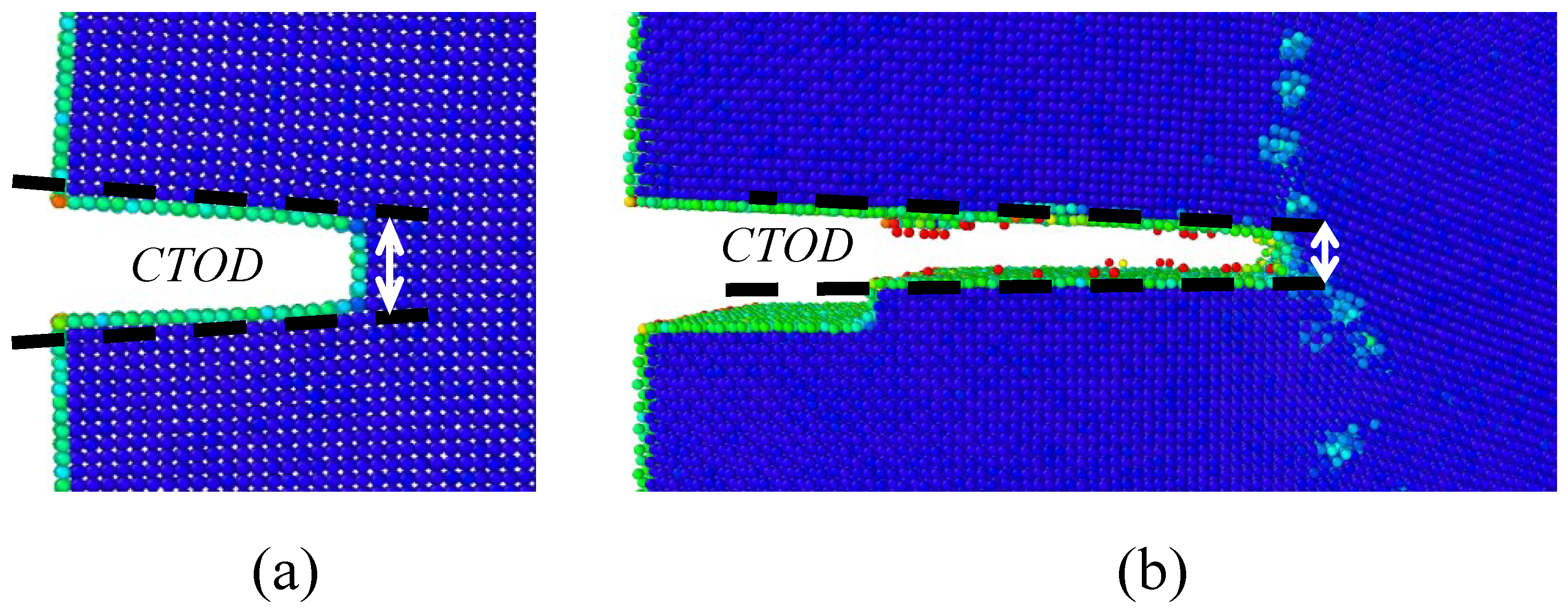
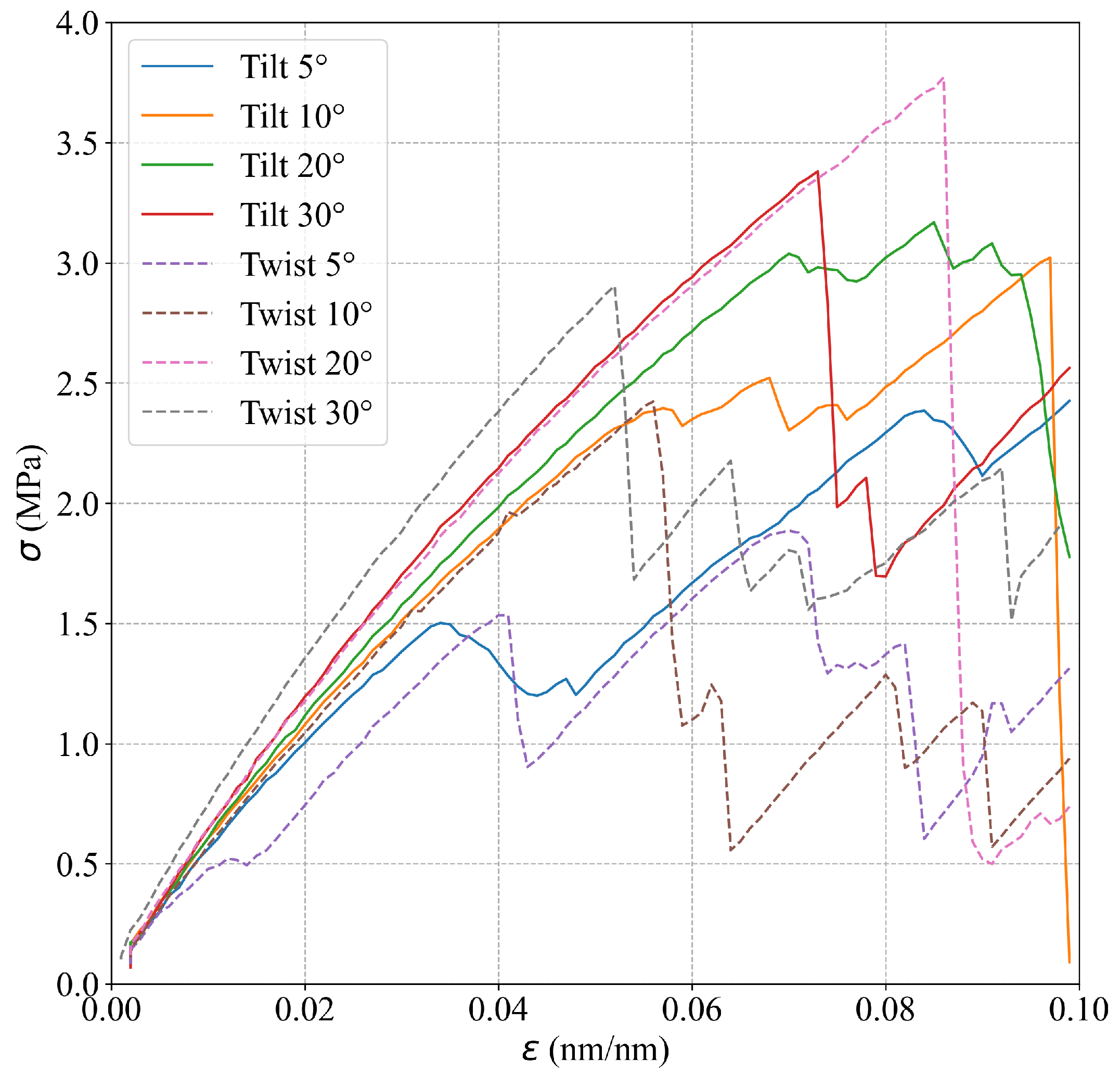

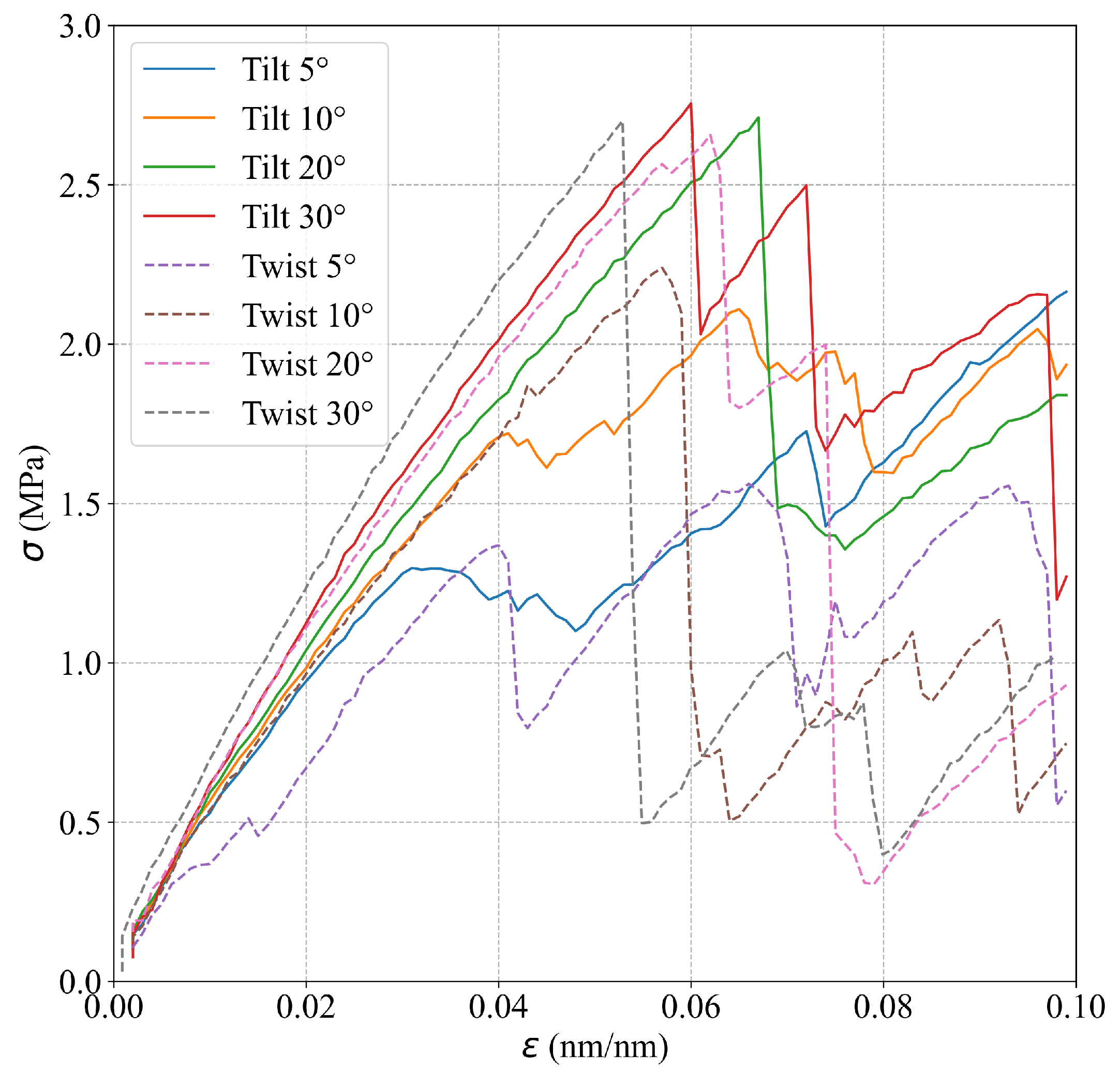

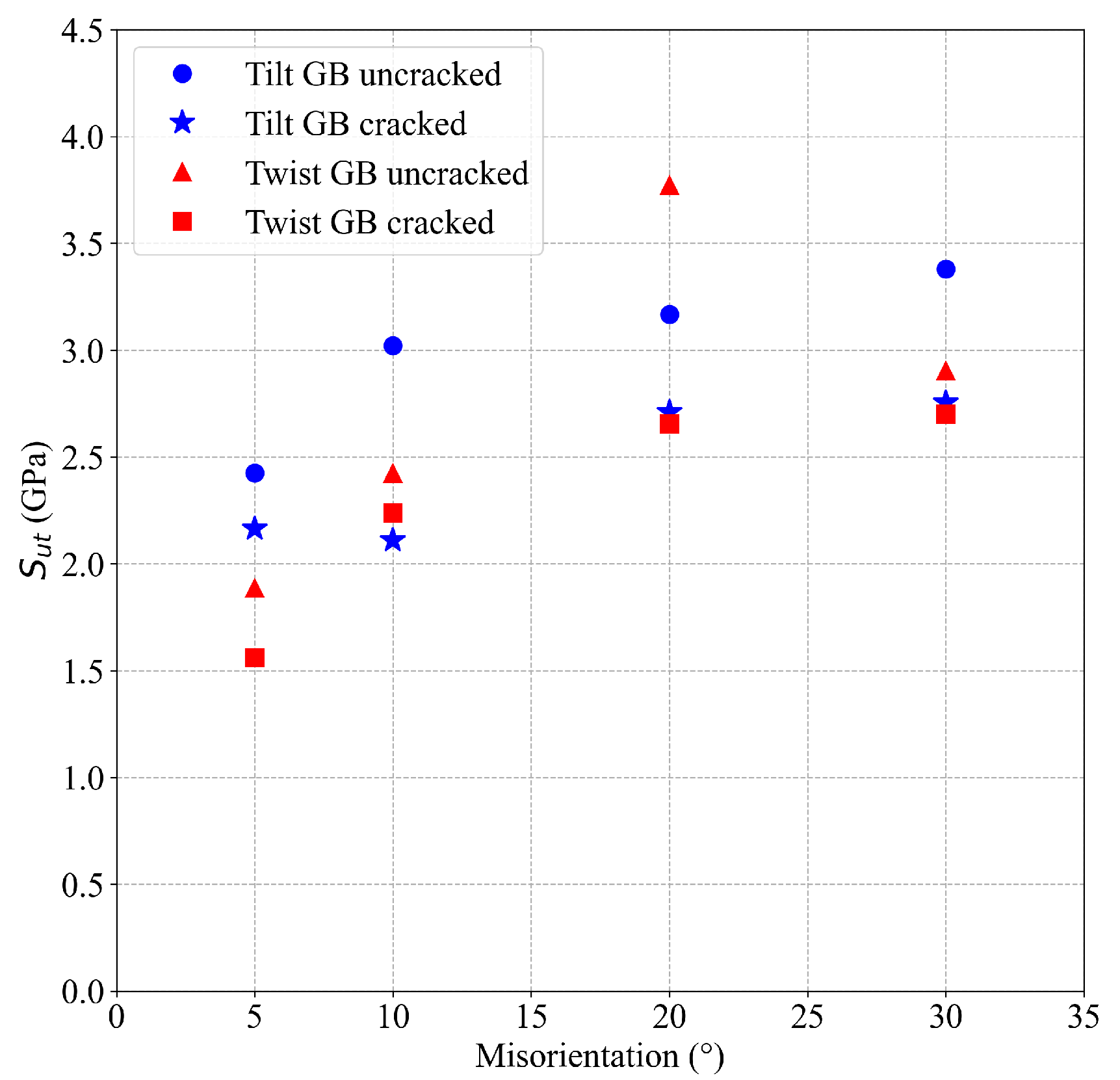
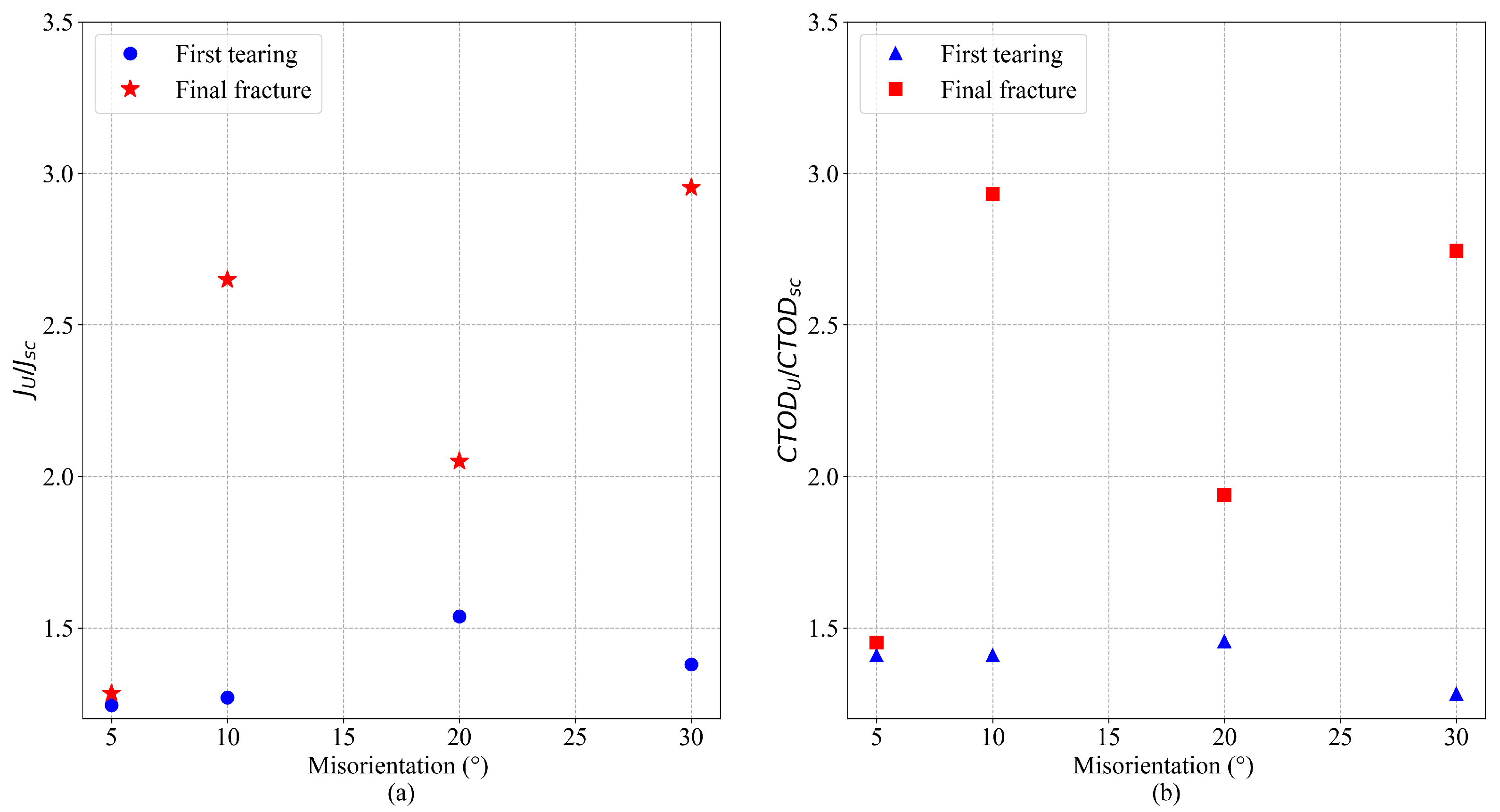
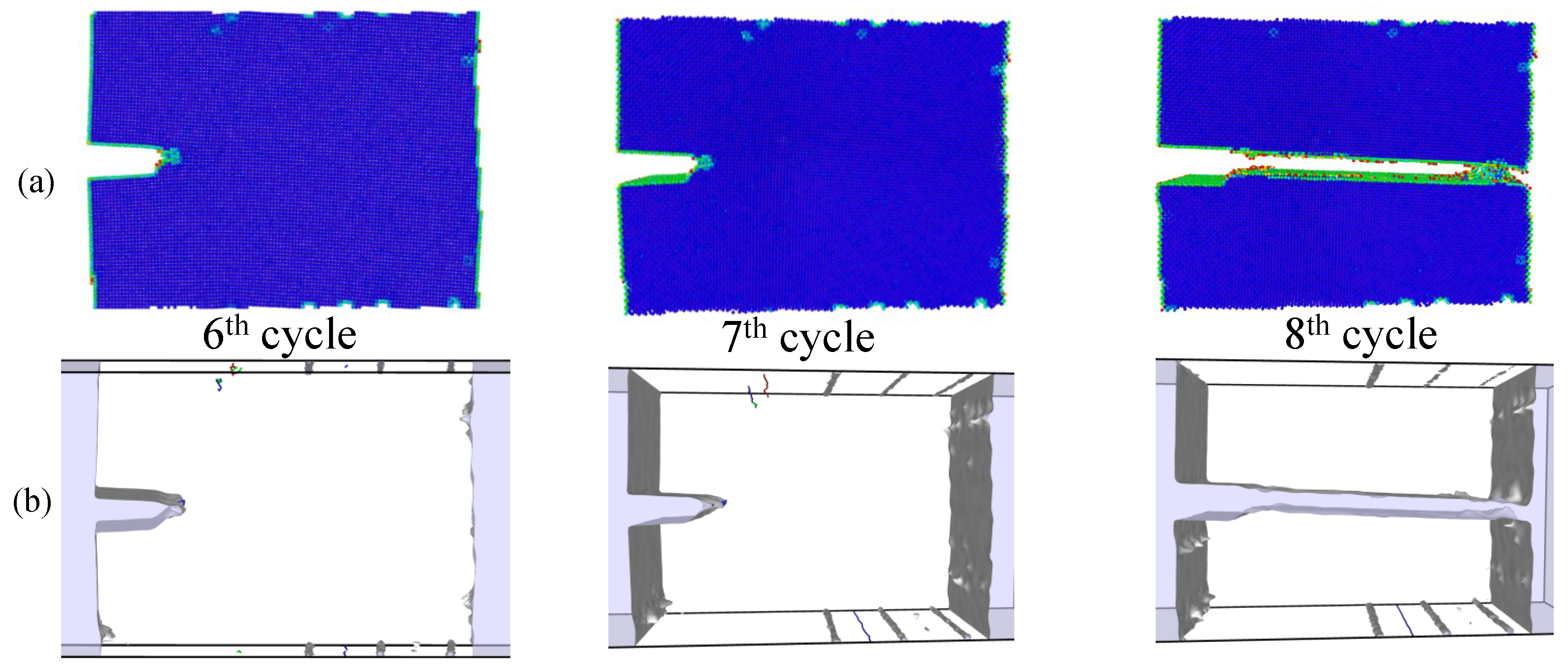
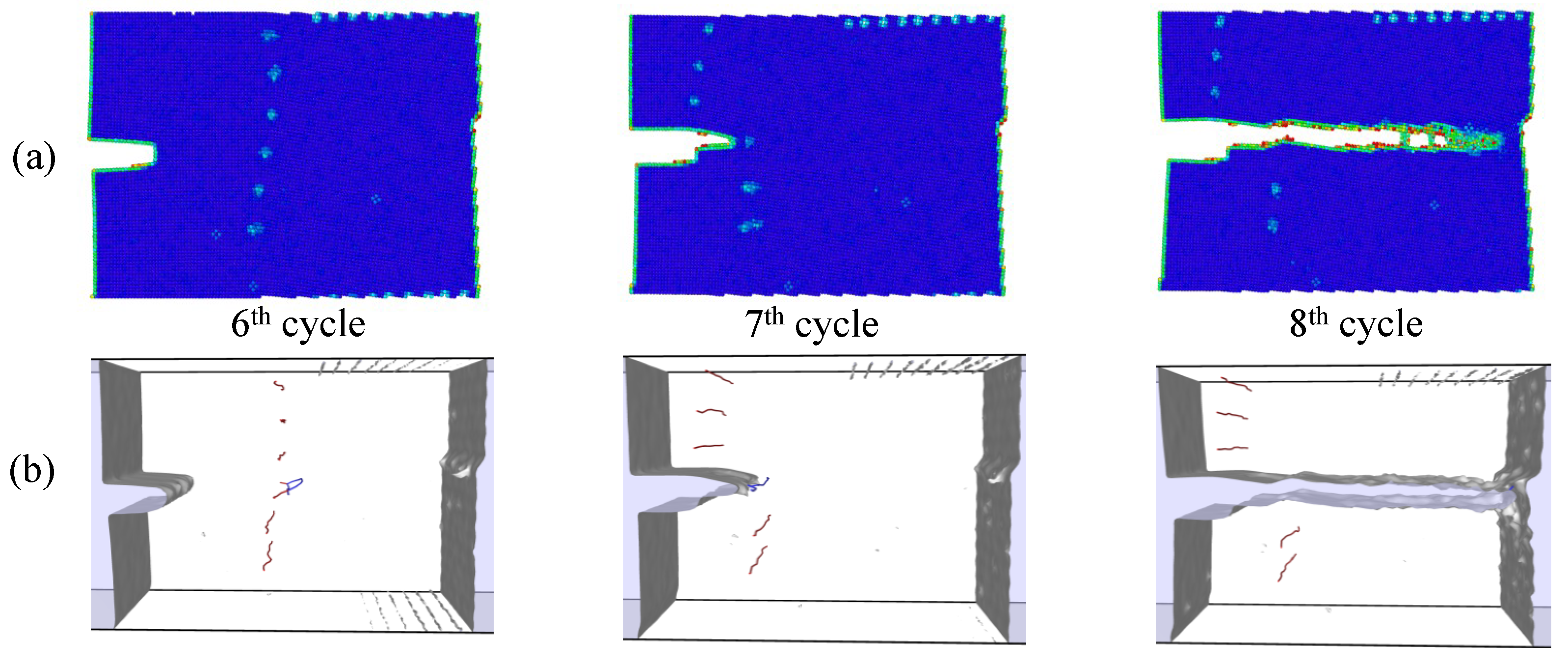
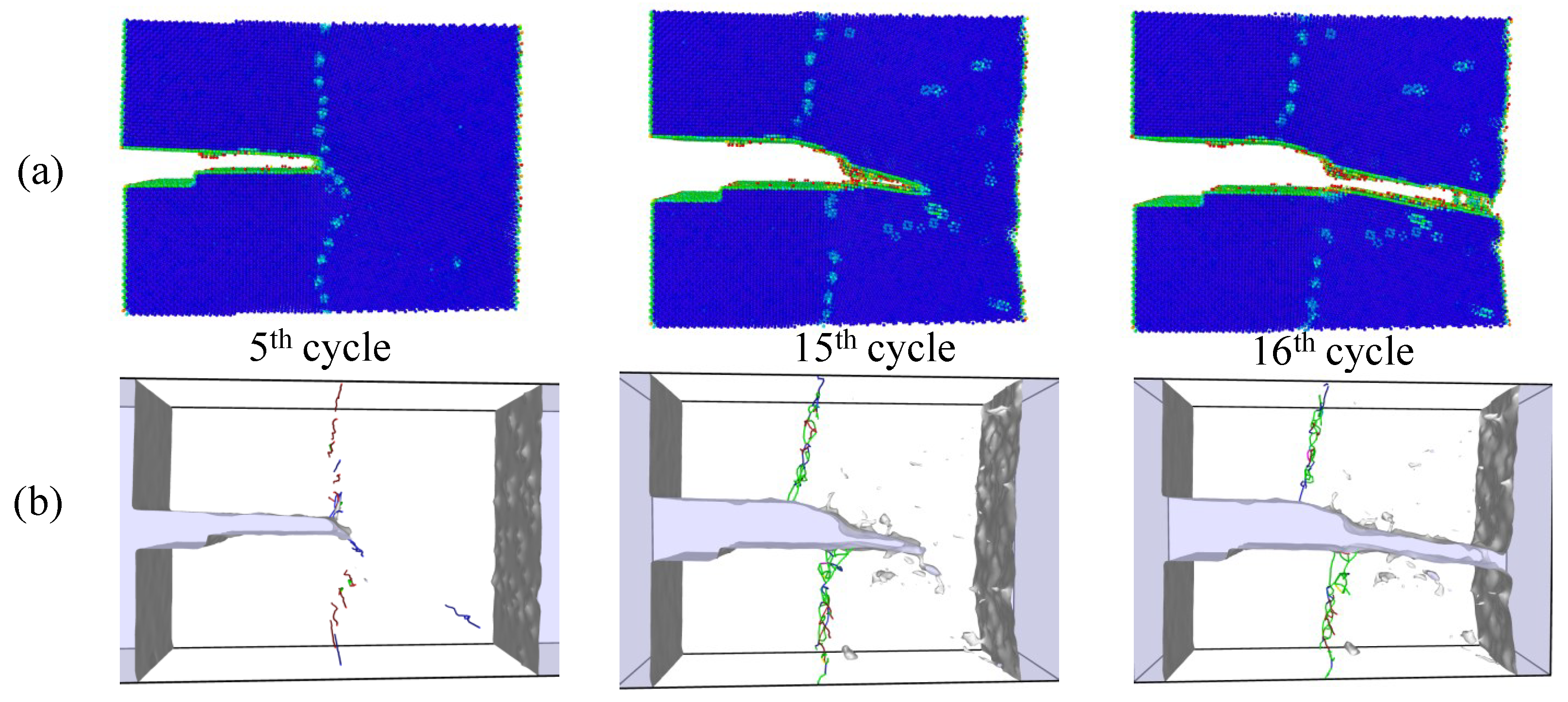



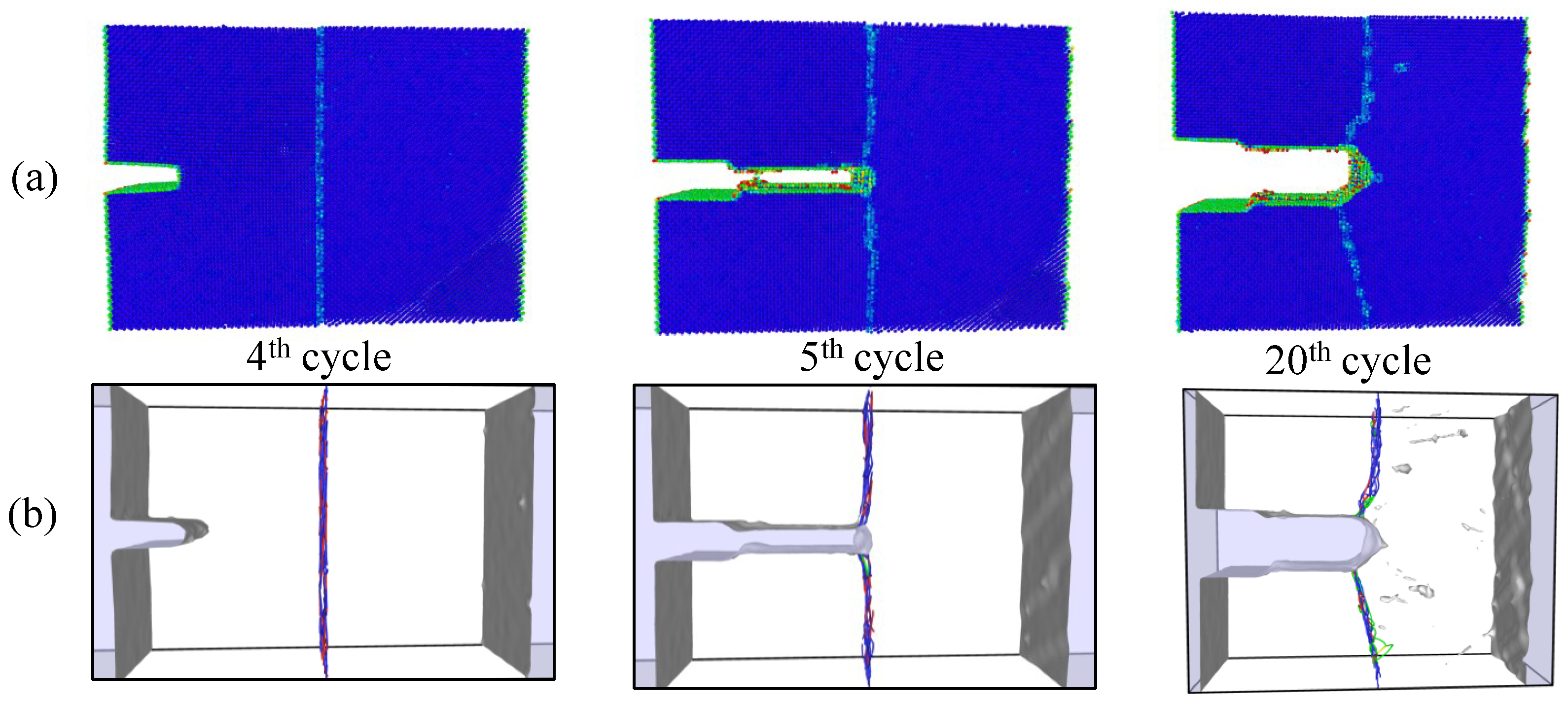


| Atomistic System | Loading | Initial Defect | GB | Angle (°) |
|---|---|---|---|---|
| Single crystal | Monotonic | Edge crack | - | - |
| Cyclic | Edge crack | - | - | |
| Bicrystal | Monotonic | Edge crack | Tilt () | 5, 10, 20, 30 |
| Monotonic | Edge crack | Twist () | 5, 10, 20, 30 | |
| Monotonic | - | Tilt () | 5, 10, 20, 30 | |
| Monotonic | - | Twist () | 5, 10, 20, 30 | |
| Cyclic | Edge crack | Tilt () | 5, 10, 20, 30 | |
| Cyclic | Edge crack | Twist () | 5, 10, 20, 30 |
| GB | Angle (°) | E (GPa) | (GPa) |
|---|---|---|---|
| Tilt | 5 | 59.72 | 2.4200 |
| 10 | 61.20 | 3.0211 | |
| 20 | 62.06 | 3.1683 | |
| 30 | 61.30 | 3.3804 | |
| Twist | 5 | 64.33 | 1.8857 |
| 10 | 65.25 | 2.4225 | |
| 20 | 69.87 | 3.7715 | |
| 30 | 67.50 | 2.9035 |
| Angle (°) | (nm) | (nm) | (GPa) | (J/m2) | (J/m2) | |
|---|---|---|---|---|---|---|
| Tilt GB | 5 | 1.987 | 2.045 | 2.267 | 3.53 | 3.64 |
| 10 | 1.987 | 4.133 | 2.313 | 3.61 | 7.51 | |
| 20 | 2.052 | 2.733 | 2.711 | 4.36 | 5.81 | |
| 30 | 1.807 | 3.870 | 2.755 | 3.91 | 8.37 | |
| Twist GB | 5 | - | - | 1.561 | - | - |
| 10 | - | - | 2.239 | - | - | |
| 20 | 1.406 | - | 2.655 | 2.93 | - | |
| 30 | 1.533 | - | 2.700 | 3.25 | - |
Disclaimer/Publisher’s Note: The statements, opinions and data contained in all publications are solely those of the individual author(s) and contributor(s) and not of MDPI and/or the editor(s). MDPI and/or the editor(s) disclaim responsibility for any injury to people or property resulting from any ideas, methods, instructions or products referred to in the content. |
© 2023 by the authors. Licensee MDPI, Basel, Switzerland. This article is an open access article distributed under the terms and conditions of the Creative Commons Attribution (CC BY) license (https://creativecommons.org/licenses/by/4.0/).
Share and Cite
Velilla-Díaz, W.; Zambrano, H.R. Effects of Grain Boundary Misorientation Angle on the Mechanical Behavior of Al Bicrystals. Nanomaterials 2023, 13, 3031. https://doi.org/10.3390/nano13233031
Velilla-Díaz W, Zambrano HR. Effects of Grain Boundary Misorientation Angle on the Mechanical Behavior of Al Bicrystals. Nanomaterials. 2023; 13(23):3031. https://doi.org/10.3390/nano13233031
Chicago/Turabian StyleVelilla-Díaz, Wilmer, and Habib R. Zambrano. 2023. "Effects of Grain Boundary Misorientation Angle on the Mechanical Behavior of Al Bicrystals" Nanomaterials 13, no. 23: 3031. https://doi.org/10.3390/nano13233031






